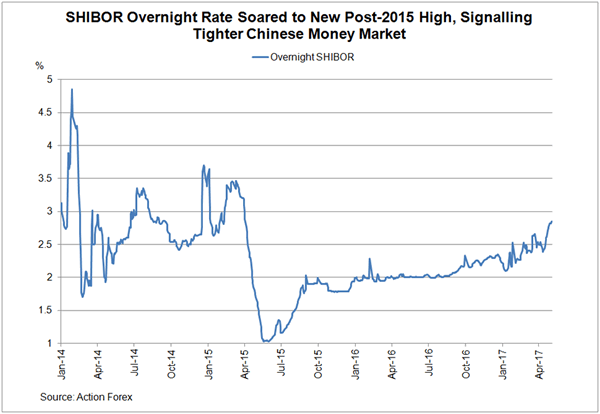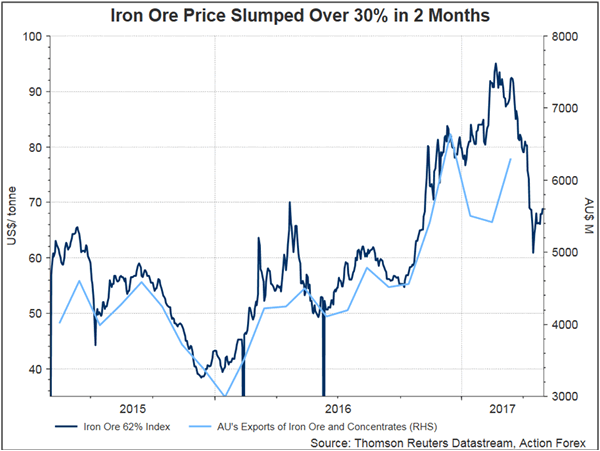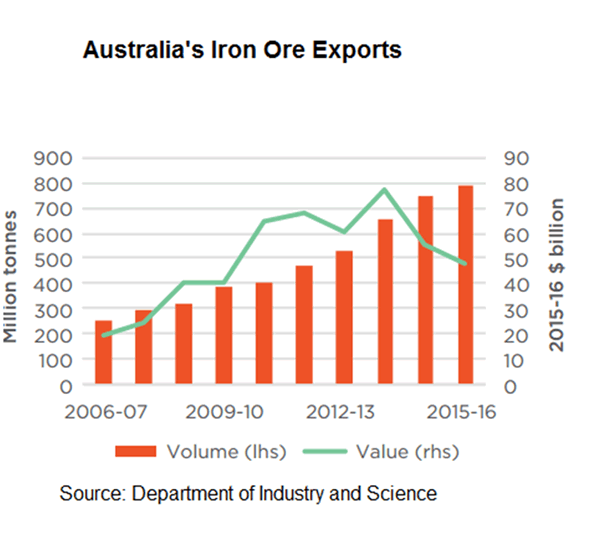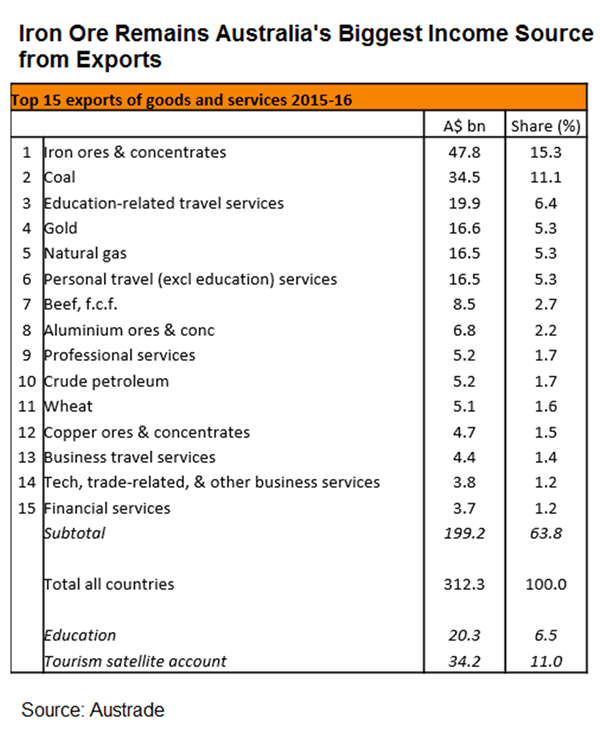We view the recent decline in Australian dollar as a catch-up of the selloff of the iron ore price from its February peak. Spot price for 62% benchmark iron ore slumped more than 30% in 2 months after reading a peak of US$90/tones on February 21. During the period, AUDUSD had been trading within a broad range and dropped around -2%. The relatively resilience in Aussie was likely driven by the broad-based weakness in the greenback as soft dataflow had diminished expectations of a rate June rate hike. Recall the selloff of iron ore prices accelerated in March, after China’s pledge reduce steel capacity. The tighter liquidity conditions in China’s money markets have reinforced concerns over the government’s efforts to crack down the steel industry.


Iron Ore Price Trend
Iron ore has been traded with high volatility since late last year. Spot price for 62% benchmark iron ore (62% iron content is comparable to the average quality of iron ore exported from Australia) jumped from US$55/tonne in October 2016 to US$96/tone in February 2017. One-third of the +75% gains made over the 4-month period was erased in two months, thanks to the Chinese government’s pledge in early March to cut steel capacity. At the time of writing this report, the benchmark has recovered to around 69.5 from April’s low of 63.5. Risk of the price is skewed to the downside as demand from China is worrisome. Indeed, China’s Dalian iron ore futures slumped more than -7.6% today, their biggest one-day decline since November 2016, as futures for steel reinforcing bar(rebar) and coking coal also got dumped. The situation would likely drag the 62% iron ore benchmark, resuming its selloff.

Iron Ore and China’s Steel Industry
Iron ore and coking coal are predominant inputs for steelmaking. According to World Steel Association, the traditional blast furnace/basic oxygen converter method of producing crude steel requires on average around 1.4 tonnes of iron ore and 0.8 tonnes of coking coal to produce a tonne of steel. As the world’s biggest steel producer, China is also the number one iron ore importer in terms of volume. As such, china’s domestic steel price, and the prices of iron ore and coking coal are closely linked.
Iron ore inventory in China soared to a record of 132.45M tones in March and stayed at an elevated 130.55M tones in April, compared with around 80B tones in mid-2015.. Over 50% (68M tones) of the stockpile was from Australia. Meanwhile, China crude steel production reached a record 72M tonnes in March and the output has remained robust in the 20 days of April.
In March, Chinese Premier Li Kequiang indicated that the government aims at closing 100-150M tonnes of steel capacity and 800 million tonnes of outdated coal capacity, by 2020. The government, however, failed to comply with its 2016 target to eliminate 45M tonnes of steel capacity with output gaining +1.2% to 808.4M tones. However, If the government is determined enough to crack down the steel capacity this time, it would mean a sharp decline in output from the current level. Moreover, given the ample supply in iron ore, a key factor of production for steel, the imports outlook would be dismal. Indeed, vessel-tracking and port data indicated that China’s iron ore imports fell -3.7% m/m to 83.27M tones in April, the lowest since September 2016 other than February which was derailed by Lunar New Year. The data also signaled that much of the decline came from Australia, where China imported 53.9M tones of iron ore in April, down from 58.9M tonnes in March.
Relationship with Australian Economy
Iron ore is a commodity critical to Australia’s budget, its terms of trade and its economic growth. Australia is the second largest global producer by gross weight in 2014, with 817M tonnes million tonnes produced. This accounted 39% of world production. It is the world’s largest exporter of iron ore, at 786M tones in volume term and AUD 48B in value term, as of 2015-16. That is Australia is exporting over 95% of the iron ore it produces.
According to Australian Trade Commission, iron ore continued to be the country’s largest export earner in 2016, accounting for AUD47.8B exports, or more than 15% of the total. Yet, this also marked a drop of AUD6.8B from the prior year, due to the impact of lower iron ore prices over the year.
As mentioned above, China’s iron ore imports sank to the lowest level since September 2016. Indeed, much of the decline came from Australia, where China imported 53.9M tones of iron ore in April, down from 58.9M tonnes in March. The outlook of China’s steel industry and its demand for iron ore would be influential to Australia’s economic developments.














